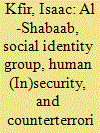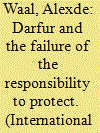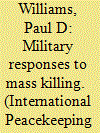| Srl | Item |
| 1 |
ID:
154988


|
|
|
|
|
| Summary/Abstract |
This article examines the link between human security, social identity, and al-Shabaab. The first section explores how social identity group theory can help explain al-Shabaab's recruitment. The second part focuses on the counterterrorism campaign against al-Shabaab, which involves decapitation, aggressive peacekeeping through a proxy in the shape of the African Union Mission in Somalia, and the role of a domestic de-radicalization program. The article concludes that al-Shabaab's allure is in decline and the group is facing internal turmoil, which makes its overtures toward the Islamic State of Iraq and the Levant very dangerous, as al-Shabaab could act as an effective conduit between the Arabian Peninsula and Africa.
|
|
|
|
|
|
|
|
|
|
|
|
|
|
|
|
| 2 |
ID:
079881


|
|
|
|
|
| Publication |
2007.
|
| Summary/Abstract |
When official representatives of more than 170 countries adopted the principle of the 'responsibility to protect' (R2P) at the September 2005 World Summit, Darfur was quickly identified as the test case for this new doctrine. The general verdict is that the international community has failed the test due to lack of political will. This article argues that the failure is real but that it is more fundamentally located within the doctrine of R2P itself. Fulfilling the aspiration of R2P demands an international protection capability that does not exist now and cannot be realistically expected. The critical weakness in R2P is that the 'responsibility to react' has been framed as coercive protection, which attempts to be a middle way between classic peacekeeping and outright military intervention that can be undertaken without the consent of the host government. Thus far, theoretical and practical attempts to create this intermediate space for coercive protection have failed to resolve basic strategic and operational issues. In addition, the very act of raising the prospect of external military intervention for human protection purposes changes and distorts the political process and can in fact make a resolution more difficult. Following an introductory section that provides background to the war in Darfur and international engagement, this article examines the debates over the R2P that swirled around the Darfur crisis and operational concepts developed for the African Union Mission in Sudan (AMIS) and its hybrid successor, the UN-African Union Mission in Darfur (UNAMID), especially during the Abuja peace negotiations. Three operational concepts are examined: ceasefire, disarmament and civilian protection. Unfortunately, the international policy priority o bringing UN troops to Darfur had an adverse impact on the Darfur peace talks without grappling with the central question of what international forces would do to resolve the crisis. Advocacy for the R2P set an unrealistic ideal which became the enemy of achievable goals
|
|
|
|
|
|
|
|
|
|
|
|
|
|
|
|
| 3 |
ID:
068277


|
|
|
| 4 |
ID:
153952


|
|
|
|
|
| Summary/Abstract |
Protecting civilians from conflict and atrocities has become a major focus of governments, the UN, and activists. Yet peace operations—the main policy instrument for directly shielding civilians from violence—vary widely in how well they are designed to do so. One much-maligned problem is a gap between a force's ambitions to protect civilians and its physical resources for doing so. Missions plagued by these ambitions–resources gaps gesture toward protecting civilians but are not designed to do so effectively. They can also worsen civilian suffering. This article explores the politics behind these gaps, focusing on the role of powerful states—especially major Western democracies—in creating and facilitating them. It argues that ambitions–resources gaps represent a form of organized hypocrisy that helps political leaders balance competing normative and material pressures to protect civilians while limiting costs and risks. Case studies of France's Operation Turquoise in Rwanda and US support for the African Union Mission in Sudan (AMIS) in Darfur support the argument.
|
|
|
|
|
|
|
|
|
|
|
|
|
|
|
|